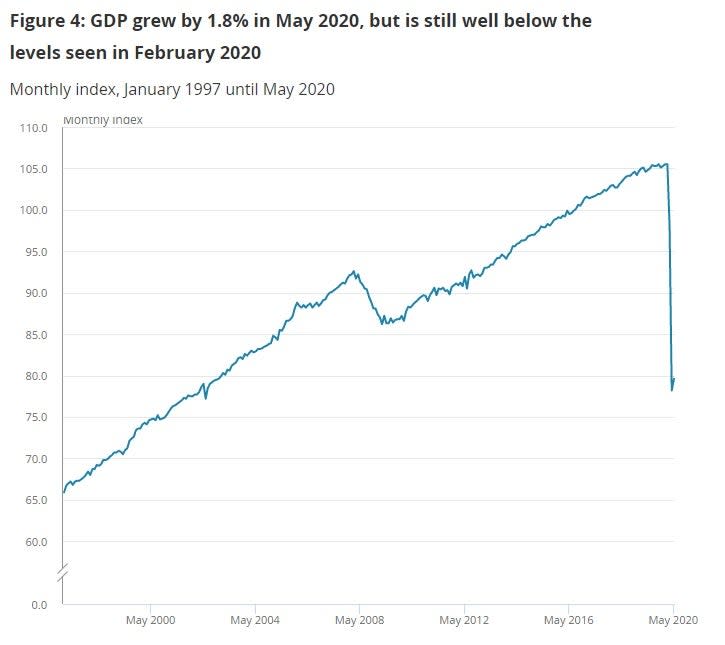UK GDP grows by 1.8% in May as hopes for a V-shaped recovery diminish

Fears of a prolonged slump deepened today when it emerged that Britain’s economy bounced only 1.8 per cent in May following the steepest fall on record in April.
The meager rise in GDP was well below City forecasts of a five to ten per cent uplift and will dampen hopes of a healthy V-shaped recovery from the impact of the coronavirus lockdown.
It will also increase the pressure on Boris Johnson’s Government to accelerate the return to work and get the economy firing again.
May’s figure follows a 6.9 per cent contraction in March and a record breaking 20.3 per cent fall in April, the only complete month of full lockdown.
Economists had been expecting the biggest ever monthly rise in GDP in May as the lockdown began to be eased for the first time in the middle of the month.
However the 1.8 per cent figure did not even beat the 1.9 per cent recorded in July 2012 when the economy was boosted by spending during the Olympics. The dominant services sector - which accounts for four fifths of the economy - inched forward just 0.9 per cent.
Chancellor of the Exchequer, Rishi Sunak, said: “Today’s figures underline the scale of the challenge we face. I know people are worried about the security of their jobs and incomes.
“That’s why I set out our Plan for Jobs last week, following the PM’s new deal for Britain, to protect, support and create jobs as we safely reopen our economy.”

“Our clear plan invests up to £30bn in significant and targeted support to put people’s livelihoods at the centre of our national renewal as we emerge through the other side of this crisis.”
For the three months to May output was down 19.1 per cent and the economy is almost a quarter smaller than before the pandemic started, wiping out more than 17 years of growth. The biggest sector falls were in restaurant and hotels, which were 71.7 per cent lower, and education, down 37.8 per cent.
Jonathan Athow, Deputy National Statistician for Economic Statistics, said:“Manufacturing and house building showed signs of recovery as some businesses saw staff return to work. Despite this, the economy was still a quarter smaller in May than in February, before the full effects of the pandemic struck.
“In the important services sector, we saw some pickup in retail, which saw record online sales. However, with lockdown restrictions remaining in place, many other services remained in the doldrums, with a number of areas seeing further declines.”
Thomas Pugh, UK economist at forecasters Capital Economics, said: “The 1.8 per cent rise in GDP in May is a disappointing first step on the road to recovery and suggests that hopes of a rapid rebound from the lockdown are wide of the mark. Indeed, the path to full economic recovery will probably be much longer than most people anticipate.
“The rebound was pretty weak across the board with construction, where workers were encouraged to return to sites in May, only rising by 8.2 per cent. The rebound in industrial production was even more lacklustre, rising by just 6.0 per cent. But the most worrying aspect was the dismal 0.9 per cent increase in services output.”
There are mounting fears that the UK economy is now permanently scarred by coronavirus.
BCC, head of economics, Suren Thiru said: "While UK economic output may grow further in the short term as restrictions ease, this may dissipate as the economic scarring caused by the pandemic starts to bite, particularly as government support winds down.
"Although some of the individual measures announced in the Summer Statement were welcome, more significant fiscal stimulus is likely to be needed to help kickstart a sustained recovery.
"This should include new incentives for business investment and reducing the overall cost of employment through a cut in employer national insurance contributions."
Read more
John Lewis to close eight more stores across the UK
John Lewis store closures: A full list of UK shops closing
How can John Lewis be turned around?
Ocado revenues surge as locked down shoppers buy food online


